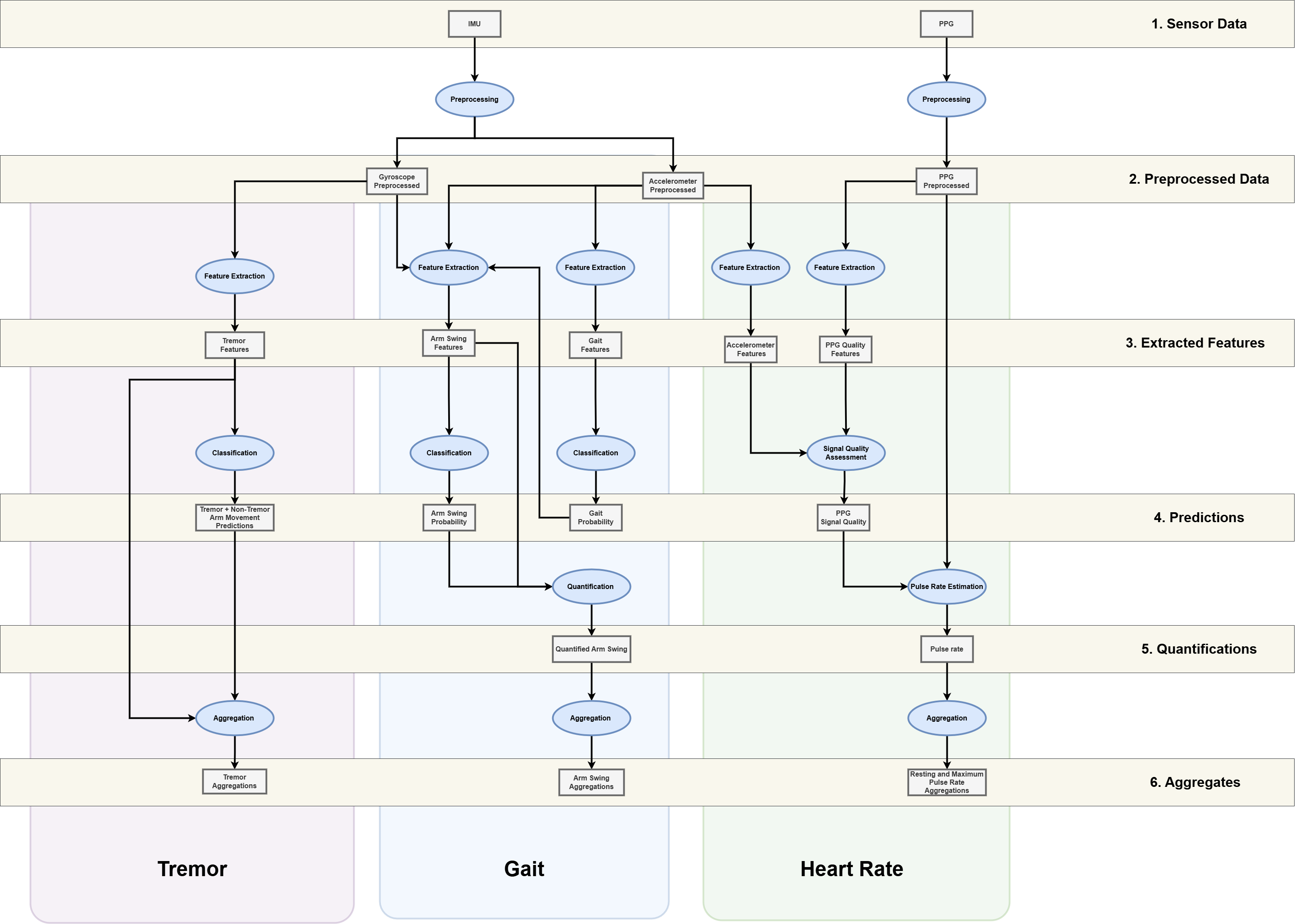
Badges |
|
|---|---|
Packages and Releases |
|
DOI |
|
Build Status |
|
License |
Overview
The Parkinson’s disease Digital Markers (ParaDigMa) toolbox is a Python software package designed for processing real-life wrist sensor data to extract digital measures of motor and non-motor signs of Parkinson’s disease (PD).
Specifically, the toolbox is designed to process accelerometer, gyroscope and photoplethysmography (PPG) signals, collected during passive monitoring in daily life. It contains three data processing pipelines: (1) arm swing during gait, (2) tremor, and (3) pulse rate. These pipelines are scientifically validated for their use in persons with PD. Furthermore, the toolbox contains general functionalities for signal processing and feature extraction, such as filtering, peak detection, and spectral analysis.
The toolbox is accompanied by a set of example scripts and notebooks for each processing pipeline that demonstrate how to use the toolbox for extracting digital measures. In addition, the toolbox is designed to be modular, enabling researchers to easily extend the toolbox with new algorithms and functionalities.
Features
The components of ParaDigMa are shown in the diagram below.

ParaDigMa can best be understood by categorizing the sequential processes:
Process |
Description |
|---|---|
Preprocessing |
Preparing raw sensor signals for further processing |
Feature extraction |
Extracting features based on windowed sensor signals |
Classification |
Detecting segments of interest using validated classifiers (e.g., gait segments) |
Quantification |
Extracting specific measures from the detected segments (e.g., arm swing measures) |
Aggregation |
Aggregating the measures over a specific time period (e.g., week-level aggregates) |
ParaDigMa contains the following validated processing pipelines (each using the processes described above):
Pipeline |
Input |
Output classification |
Output quantification |
Output week-level aggregation |
|---|---|---|---|---|
Arm swing during gait |
Wrist accelerometer and gyroscope data |
Gait probability, gait without other arm activities probability |
Arm swing range of motion (RoM) |
Typical & maximum arm swing RoM |
Tremor |
Wrist gyroscope data |
Tremor probability |
Tremor power |
% tremor time, typical & maximum tremor power |
Pulse rate |
Wrist PPG and accelerometer data |
PPG signal quality |
Pulse rate |
Resting & maximum pulse rate |
Installation
The package is available in PyPI and requires Python 3.11 or higher. It can be installed using:
pip install paradigma
Usage
Tutorials & documentation
See our tutorials for example scripts on how to use the toolbox to extract digital measures from wrist sensor signals. The API reference contains detailed documentation of all toolbox modules and functions. The user guides provide additional information about specific topics (e.g. the required orientation of the wrist sensor).
Sensor data requirements
The ParaDigMa toolbox is designed for the analysis of passive monitoring data collected using a wrist sensor in persons with PD.
Specific requirements include:
Pipeline |
Sensor Configuration |
Context of Use |
|---|---|---|
All |
- Sensor position: wrist-band on most or least affected side (validated for both, but different sensitivity for measuring disease progression for tremor and arm swing during gait). |
- Population: persons with PD. |
Arm swing during gait |
- Accelerometer: minimum sampling rate of 100 Hz, minimum range of ± 4 g. |
- Population: no walking aid, no severe dyskinesia in the watch-sided arm. |
Tremor |
- Gyroscope: minimum sampling rate of 100 Hz, minimum range of ± 1000 degrees/sec. |
- Compliance: for weekly measures: at least three compliant days (with ≥10 hours of data between 8 am and 10 pm). |
Pulse rate |
- PPG*: minimum sampling rate of 30 Hz, green LED. |
- Population: no rhythm disorders (e.g. atrial fibrillation, atrial flutter). |
* The processing of PPG signals is currently based on the blood volume pulse (arbitrary units) obtained from the Verily Study Watch. This part of the PPG tutorial provides code and documentation on how to use the pipeline with other PPG devices.
[!WARNING] While the toolbox is designed to work on any wrist sensor device which fulfills the requirements, we have currently verified its performance on data from the Gait-up Physilog 4 (arm swing during gait & tremor) and the Verily Study Watch (all pipelines). Furthermore, the specifications above are the minimally validated requirements. For example, while ParaDigMa works with accelerometer and gyroscope data sampled at 50 Hz, its effect on subsequent processes has not been empirically validated.
We have included support for TSDF as format for loading and storing sensor data. TSDF enables efficient data storage with added metadata. However, ParaDigMa does not require a particular method of data storage and retrieval. Please see our tutorial Data preparation for examples of loading TSDF and other data formats into memory, and for preparing raw sensor data as input for the processing pipelines.
Scientific validation
The pipelines were developed and validated using data from the Parkinson@Home Validation study [Evers et al. (2020)] and the Personalized Parkinson Project [Bloem et al. (2019)]. The following publications contain details and validation of the pipelines:
Contributing
We welcome contributions! Please check out our contributing guidelines. Please note that this project is released with a Code of Conduct. By contributing to this project, you agree to abide by its terms.
License
It is licensed under the terms of the Apache License 2.0 license. See License for more details.
Acknowledgements
The core team of ParaDigMa consists of Erik Post, Kars Veldkamp, Nienke Timmermans, Diogo Coutinho Soriano, Peter Kok, Vedran Kasalica and Luc Evers.
Advisors to the project are Max Little, Jordan Raykov, Twan van Laarhoven, Hayriye Cagnan, and Bas Bloem.
The initial release of ParaDigMa was funded by the Michael J Fox Foundation (grant #020425) and the Dutch Research Council (grant #ASDI.2020.060 & grant #2023.010).
ParaDigMa was created with cookiecutter and the py-pkgs-cookiecutter template.
Contact
Questions, issues or suggestions about ParaDigMa? Please reach out to paradigma@radboudumc.nl, or open an issue in the GitHub repository.
User guides
Developer docs
API




